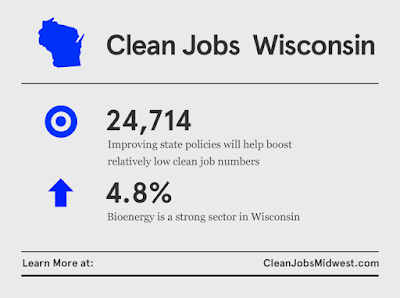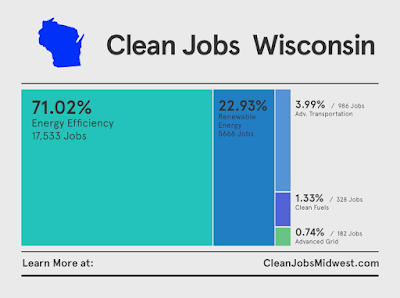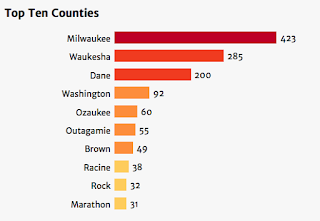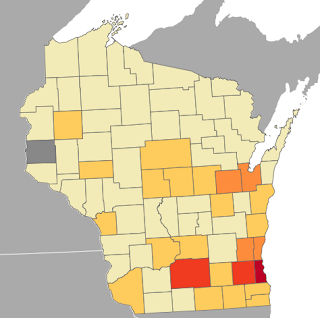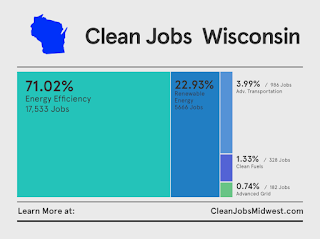
by jboullion | Mar 28, 2016 | Uncategorized
By: Tyler Huebner, Executive Director, RENEW Wisconsin
Last week, two reports came out that demonstrate the incredible value of Wisconsin’s Focus on Energy program to our state’s citizens and economy.
Focus on Energy is the program that people and businesses across the state use for rebates, advice, and technical support to save money by using less energy.
The first was a report issued by a group called the Clean Energy Trust. It showed the number of people across 12 Midwest states who work in the delivery of energy saving products and services and renewable energy technologies.
In Wisconsin, we have nearly 25,000 people working in these industries according to the report. Companies like Miron Construction in Neenah, Broadwind Towers in Manitowoc, Cree Lighting in Racine, Trane in La Crosse, and countless small businesses throughout the state are delivering energy solutions for businesses and residents.
However, of the twelve Midwestern states surveyed, Wisconsin ranked last in the number of persons working in these industries on a per capita basis. The report clearly shows that Wisconsin has a tremendous opportunity to tap these sectors for further employment growth.
The second report was a draft “Strategic Energy Assessment” from the state of Wisconsin’s Public Service Commission. This report showed that Wisconsin has the highest electricity rates of eight Midwestern states.
 |
Sisters of St. Francis Solar Installation, which was made
possible by a Focus on Energy Rebate. |
However, because our citizens use energy more efficiently, our monthly energy bills aren’t the highest. In fact, our monthly bills are among the lowest in the region.
The Public Service Commission identified the energy-smart nature of our citizens and specifically pointed to the Focus on Energy program for enabling citizens to save money on their monthly bills.
It’s against the backdrop of these reports that our Legislature has recently passed a bill, AB 804, that cuts $7 million each year out of Wisconsin’s highly successful Focus on Energy program. The bill is sitting on the Governor’s desk, and it is my understanding that the Governor has the ability to line-item veto that provision in the bill.
Funding for Focus on Energy should be kept whole.
Focus on Energy delivers $3.33 in savings for every dollar invested. The program keeps energy bills lower for citizens and businesses, despite Wisconsin’s higher rates. Focus on Energy is supporting thousands of jobs, but Wisconsin is behind our neighboring states. A cut to this program will only make that gap larger.
More jobs. Less waste. Saving money. Common sense goals for a stronger Wisconsin, and Focus on Energy is delivering. Let’s keep this program strong now, and for years to come.

by jboullion | Mar 22, 2016 | Uncategorized
FOR IMMEDIATE RELEASE
PRESS CONTACTS: Tyler Huebner, Tyler.Huebner@renewwisconsin.org, 608-575-2201; Pat Mitchell, pmitchell@hastingsgroup.com, 703-276-3266; Jeff Benzak, jeff@e2.org; 202-513-6248.
New Report: Nearly 25,000 Clean Energy Workers in Wisconsin
Projected 2016 Growth Rate of 4.8 Percent; Milwaukee, Rural Areas Each Account for Quarter of State’s Jobs; Energy Efficiency, Renewables Standards Could Create Even More Opportunities
MADISON (March 22, 2016) – Nearly 25,000 people work in Wisconsin’s clean energy industry, according to a comprehensive analysis unveiled today by RENEW Wisconsin, Clean Energy Trust and Environmental Entrepreneurs (E2).
The analysis – available at www.CleanJobsMidwest.com – is based on U.S. Bureau of Labor Statistics data and a comprehensive survey of thousands of businesses across Wisconsin and the 12-state Midwest region. The Clean Jobs Midwest report provides detailed breakdowns of clean energy jobs not available previously – including job totals for every county, congressional district and state legislative district in Wisconsin.
“As a leading wind tower manufacturer in the U.S., Broadwind draws on Wisconsin’s deep manufacturing heritage to fabricate wind turbine towers in our Manitowoc facility,” said Eric Blashford, president of Broadwind Towers and Heavy Industries, referring to the company’s Wisconsin location on Lake Michigan between Milwaukee and Green Bay.
“This same facility that once built submarines for World War II currently employs nearly 300 people in Manitowoc, most of whom are high-skilled manufacturing staff receiving competitive pay and a good benefits package.”
“As Wisconsin transitions to a clean energy economy, many more of these well-paying jobs will be created throughout the supply chain helping Wisconsinites make a good, stable living,” Blashford said.
Energy efficiency is by far the largest clean energy sector employer in the state, with more than 17,000 people, or nearly 71 percent of the clean energy workforce, employed in areas such as high-efficiency lighting, Energy Star appliance manufacturing and high-efficiency HVAC services to reduce wasted energy in homes, schools and businesses.
According to the findings, the renewable energy industry accounts for about one in four clean energy workers in Wisconsin, or more than 5,600 jobs – including about 3,700 in solar, 1,100-plus in biomass and nearly 600 in wind. Wisconsin is one of two Midwestern states with more than 20 percent of its renewable energy generation coming from biomass.
“Wisconsin’s clean energy workers make up an important and growing sector of our economy,” said Tyler Huebner, executive director of RENEW Wisconsin. “Our last major state energy policy advancement was made ten years ago now, and although we met the goals including 10 percent renewable electricity by 2015, that policy is no longer driving investment. A new policy framework for advancing 21st-century energy solutions would create even more clean energy employment and help us catch up with our neighboring states. Clean energy policies drive job growth across the Midwest and have the potential to help create thousands of good-paying jobs in Wisconsin as well,” Huebner said.
The report also found:
– Most clean energy jobs in Wisconsin – nearly 7,500 – are found in rural areas and non-metropolitan statistical areas. The greater Milwaukee area boasts nearly 6,500 clean energy jobs.
– In contrast to Governor Scott Walker’s policy opposing the federal Clean Power Plan, nearly 68 percent of clean energy businesses in the state believe the Clean Power Plan would increase business prospects.
– Clean energy employs nearly 569,000 people across the 12-state Midwest region (Illinois, Indiana, Iowa, Kansas, Michigan, Minnesota, Missouri, Nebraska, North Dakota, Ohio, South Dakota, and Wisconsin).
“Clean energy is a dynamic sector and central to economic growth in the Midwest,” said Erik Birkerts, Chief Executive Officer of Clean Energy Trust. “Smart public policy will further accelerate the clean energy sector’s growth, which means thousands of new jobs created across the region and which will confer economic advantages on Wisconsin,” Birkerts continued.
Learn more about Wisconsin clean energy jobs here, and access additional resources for each state and region here.
RENEW Wisconsin leads and accelerates the transformation to Wisconsin’s renewable energy future through advocacy, education, and collaboration.
Clean Energy Trust (CET) fuels clean energy innovation in the Midwest. A Chicago-based non-profit, CET helps launch, fund and grow Midwest clean energy companies to ensure a more prosperous, sustainable future for generations to come. It does this through direct investment, commercialization assistance, mentorship, access to its broad partner network and the promotion of a supportive clean energy community and business climate. Learn more at http://www.cleanenergytrust.org.
Environmental Entrepreneurs (E2) is a national, nonpartisan group of business leaders, investors, and professionals from every sector of the economy who advocate for smart policies that are good for the economy and good for the environment. Our members have founded or funded more than 2,500 companies, created more than 600,000 jobs, and manage more than $100 billion in venture and private equity capital. For more information, see www.e2.org or follow us on Twitter at @e2org.
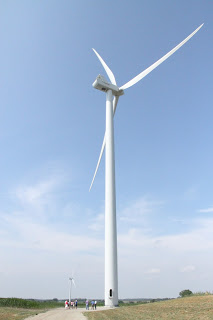
by jboullion | Mar 14, 2016 | Uncategorized
 |
| Glacier Hills Wind Project |
A new wind power project looms on the horizon for 2017. If built it will be the first large wind generation to go up in Wisconsin project since Glacier Hills in Columbia
County. All told, nearly 50 wind turbines could be built and placed in
service in Lafayette County east of Platteville, according to Vanessa
Tutos, government affairs director for project developer EDP Renewables.
The project enjoys strong support from local landowners.
Media coverage of the new wind project:
“New wind farm coming to Lafayette County brings boost to WI wind energy industry”
http://www.wkow.com/story/31459659/2016/03/13/new-wind-farm-coming-to-lafayette-county-brings-boost-to-wi-wind-energy-industry
“Wind farm drought may nearing end in Wisconsin”
http://www.jsonline.com/business/wind-powers-wisconsin-dry-spell-may-be-ending-b99683088z1-371880561.html
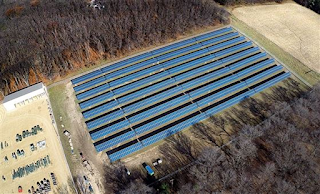
by jboullion | Mar 11, 2016 | Uncategorized
More information
Tyler Huebner, Executive Director
608-575-2201 (cell)
tyler.huebner@renewwisconsin.org
PSC Approves Madison Gas & Electric Community Solar
 |
Eau Claire Electric Cooperative’s 2015
872 kW Community Solar Array |
Madison, WI – March 11, 2016
Today, the Public Service Commission of Wisconsin, which regulates the state’s utilities, approved a Community Solar project for Madison Gas & Electric (MGE). “Community solar” is a single, larger solar project in which a large number of people collectively share in the cost to build the project and share in the benefits of the solar energy production. The MGE project will be 500 kilowatts and will be placed on the roof of the Middleton Operations Center in Middleton, WI. MGE estimates that 250 people will participate in this project.
MGE joins a host of other electric providers offering community solar in Wisconsin, but this project differs from the others in two key ways:
– Participants will pay a small up-front fee of 10% of the cost per solar panel, as opposed to paying the entire fee for a panel at once
– Participants will then pay a 12 cents per kilowatt-hour rate for the solar energy generated by the Middleton array for up to 25 years. This is higher than today’s energy-only rate. But standard electric rates are expected to rise over time and exceed the 12 cent energy-only rate in about 10 years, meaning customers will start saving money at that point. (Both standard rates and the solar rate will also see 3-4 cents per kilowatt-hour in distribution charges.)
MGE structured its program differently because it has different customer demographics and looked for a program option that would not require a large up-front fee.
“Solar energy development improves Wisconsin because it creates jobs and increases local, secure, and clean energy,” said Tyler Huebner, RENEW Wisconsin’s Executive Director. “Adding options for more customers to participate in solar is a smart business move for MGE. Nearly 90% of Wisconsinites want more solar power, but only about 1 in 4 customers can put solar on their own property. Community solar programs like this enable many more citizens to participate in building a clean energy economy. We congratulate MGE on gaining approval for this novel community solar program design, and we hope it is successful.”
MGE’s application and supplemental responses are available in Docket 3270-TE-101 at the PSC’s website, http://psc.wi.gov/.
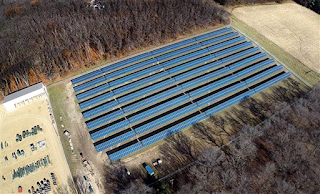
by jboullion | Mar 10, 2016 | Uncategorized
Will Dane County see its first community solar project? That all depends on the Public Service Commission’s decision on Madison Gas & Electric’s application to build a 500 kilowatt array on a brand new building owned by the City of Middleton. The PSC will decide tomorrow, March 11.
Below is an article from today’s Isthmus written by Cara Lombardo on the proposed MG&E project.
Keep on the sunny side
 |
Eau Claire Electric Cooperative 2015
872 kW Community Solar Installation |
Adam Gusse, vice president of H&H Solar in Madison, hopes his employees can start putting solar panels on the roof of Middleton’s Municipal Operations Center this June. Construction would take a month and a half and result in a solar panel array that would provide 500 kilowatts of power to up to 250 homes currently served by Madison Gas and Electric.
The project just needs approval from the Public Service Commission.
MGE expects the PSC to rule on its proposal for a solar energy pilot program by the end of the month. While community solar projects have cropped up across the state, MGE’s project would not only be the first in Dane County but also the first south of the Wisconsin Dells.
Bradley Klein, an attorney at the Environmental Law and Policy Center in Chicago, says Wisconsin has lagged neighboring states when it comes to adopting solar energy. Minnesota, in particular, is already operating community solar projects on a large scale.
“In Wisconsin, for one reason or another, it’s been hard to get the commission excited about this in the way that we’re seeing in many other states across the country,” he says.
But Klein says the MGE proposal is “a good sign” for the state, and that creating strong, stable policy to help the market grow should be a priority.
Few utilities were prepared to invest in solar energy until the price dropped by 60% over the past four years, which is driving utilities to consider owning solar themselves.
Michael Vickerman, program and policy director at RENEW Wisconsin, an organization that advocates for renewable energy, says MGE is very interested in solar energy. “What they would really like to do is just start building solar,” he says. “But right now, the PSC’s position is, ‘Utilities don’t need more generating capacity.’ If there’s no need for these arrays, then the next thing they’d look at is, if a utility goes ahead and builds them, will this add costs to other ratepayers? That’s the lens through which they look at these very modest proposals from investor-owned utilities.”
RENEW Wisconsin commends electric providers who are trying to offer a choice despite what Vickerman calls a “vacuum of policy” in Wisconsin with respect to the environmental and economic benefits of solar energy. Because the benefits haven’t received proper consideration, he says, people who want solar energy will have to pay a little more, at least initially.
Community solar allows customers to source solar energy from centralized solar panel arrays instead of having to install panels on their homes. More than half of homes are unfit for solar panels, either because the roof is shaded or not properly oriented, and community solar allows for much larger arrays.
Customers who choose to participate in community solar arrangements typically pay an initial subscription fee, which can be a few thousand dollars depending on the investment size, to fund construction. Each month, the project’s energy output is measured, and customers receive reductions on their bills based on the amount of energy generated from their shares of the array. It usually takes more than 10 years for monthly discounts to cover the initial investment. But for many, it’s an easy way to support clean energy.
MGE’s proposed project is slightly different: Instead of selling shares of the array, MGE would own it and sell customers shares of the array’s output. Under this arrangement, smaller investments would be possible, and upfront costs would be significantly lower, around $380 for an average household subscription of 2 kilowatts.
Participants would pay a level rate of $0.12 per kilowatt-hour for energy produced from the panels; the default rate is around $0.095 per kilowatt-hour. However, the solar rate would be locked in for 25 years.
Eight community solar projects currently exist in the state, six of which are rural co-ops not regulated by the PSC. Dairyland Power Cooperative, which is based in La Crosse, and Xcel Energy have both announced plans for solar projects that would nearly double the capacity of solar energy in the state.
Gusse says the project, if approved, will build on the growth of solar energy in the state and generate even more interest: “It will be exciting to see if it gets through the approval process.”

by jboullion | Mar 3, 2016 | Uncategorized
RENEW Wisconsin’s advocacy has once again made the difference for a renewable energy victory.
The Public Service Commission of Wisconsin, the state agency that regulates electric utilities, and We Energies have decided not to appeal our October 2015 Circuit Court victory. RENEW Wisconsin partnered with The Alliance for Solar Choice, a national solar energy advocacy association, on this lawsuit. David Bender of Bender Westerberg LLC represented both groups in this matter.
 The October 2015 Circuit Court decision struck down a new charge that most customers who generate their own power, whether through solar panels, small wind, biogas, hydropower, or other sources, would have faced starting in 2016.
The October 2015 Circuit Court decision struck down a new charge that most customers who generate their own power, whether through solar panels, small wind, biogas, hydropower, or other sources, would have faced starting in 2016.
The PSC or We Energies could have appealed that Circuit Court ruling, but they have chosen not to. That means We Energies’ new net metering service approved in 2014 will take effect, but without the PSC-approved “capacity demand charge” that would have reduced savings from newly installed residential solar systems by 30%.
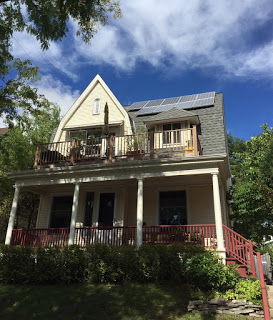 |
| Halvorsen Home Solar Installation in Milwaukee, WI |
In addition, the new net metering service sets a much higher cap for project sizes that can participate in the net metering program. The cap is now set at 300 kilowatts (kW) of AC power.
The previous cap was 20 kW, which RENEW had challenged in court following We Energies’ 2012 rate case. The 300 kW ceiling for net metered systems was proposed in 2014 by We Energies in response to our previous Circuit Court victory.
All told, our two court victories have added up to the following net metering service terms:
– Project size up to 300 kW AC, the highest cap allowed by any utility in Wisconsin
– Monthly “netting” of consumption vs. production (RENEW advocated for annual netting but did not win this point from the PSC in 2014)
– No extra charge imposed on customer-generators
We Energies typically files a new rate case every two years. If that trend continues, its next rate filing would come in Summer 2016. You can count on us to prepare for that filing along with others proposing changes to rates and distributed generation services.
Stay tuned!!

by jboullion | Feb 24, 2016 | Uncategorized
More information
Tyler Huebner, Executive Director
608-575-2201 (cell)
tyler.huebner@renewwisconsin.org
RENEW Wisconsin Applauds Dairyland Power Cooperative’s Solar Energy Leadership
 |
Overhead shot of Eau Claire Energy Cooperative’s
2015 865 kW Community Solar Project in Fall Creek, WI |
Madison, WI – Feb. 24, 2016
Today, Dairyland Power Cooperative announced that it is contracting to build 12 solar projects throughout western Wisconsin which will provide 15.5 megawatts of solar power capacity.
The projects will provide enough energy to power over 2,500 homes, according to Dairyland Power.
“We congratulate Dairyland Power Cooperative’s leadership in advancing solar energy in the State of Wisconsin,” said Tyler Huebner, Executive Director of RENEW Wisconsin.
“Wisconsin is coming off its best year ever for solar power, with 7.5 megawatts installed in 2015, three times more than any prior year. Dairyland’s announcement ensures that 2016 will surpass that and become Wisconsin’s biggest year ever for solar. In fact, it’s quite possible that the amount of solar generation coming online in 2016 alone may double the 25 megawatts already in place when the year began,” added Huebner.
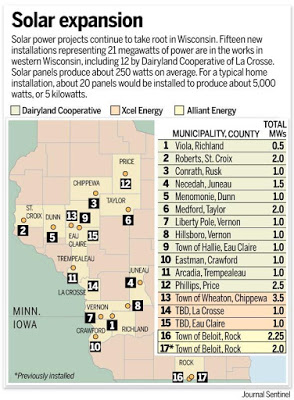 |
| Map from Milwaukee Journal Sentinel |
Other utility solar projects previously announced expected to come online in 2016 include:
– Alliant Energy & Hanwha Q Cells USA – 2.25 megawatts in the Town of Beloit
– Xcel Energy – 3.5 megawatts near Chippewa Valley Airport
– Xcel Energy – 2 megawatts of community solar projects in western Wisconsin
The Xcel Energy community solar projects were also announced Wednesday, and will be the largest community solar arrays in Wisconsin. Madison Gas & Electric has also filed with the Public Service Commission to build a 0.5 megawatt project.
“We also applaud Xcel Energy’s announcement to continue the momentum of community solar arrays in Western Wisconsin. With the cost of solar projects down 60% in the past six years, utilities, businesses, and average citizens alike are taking advantage of affordable and clean solar power,” added Huebner.
Media coverage of the announcements:
– Milwaukee Journal Sentinel
– La Crosse Tribune
by jboullion | Feb 11, 2016 | Uncategorized
On Tuesday, February 10th, 2016, RENEW Wisconsin gave the below comments on AB 804, a bill that proposes to cut $7 million from the Focus on Energy program.
Comments of RENEW Wisconsin
To Joint Finance Committee
AB 804 – Public Service Commission Reform Bill
February 10, 2016, 10 AM Hearing
My name is Tyler Huebner, and I am the Executive Director of RENEW Wisconsin. RENEW Wisconsin is a membership-based organization that represents over 400 individuals and over 50 businesses in the renewable energy industry in Wisconsin.
Thank you for the opportunity to appear today. My comments today are confined to the Focus on Energy funding portion of this bill.
1. The Focus on Energy Program has historically been, and continues to be, an unqualified success for the state of Wisconsin’s citizens, businesses, and economy.
The latest evaluation report shows that in 2014, $3.33 in energy-related benefits were provided for every $1 invested in the program. These annual evaluations are conducted by an independent company.
When economic benefits such as job creation and dollar flows through the Wisconsin economy are included, the program returns double that: over $6.60 per dollar invested in the Focus on Energy Program.
2. Wisconsin’s electricity rates are now THE HIGHEST in the Midwest, according to the federal Energy Information Administration. Businesses and homeowners need programs like Focus on Energy to be able to control their energy bills.
Our electricity rates have increased steadily in Wisconsin over the past 15 years. From 2000 to 2012, Wisconsin’s average electricity rate increases were the third highest in the whole country – an increase of 80%.
There is very little that the average Wisconsin citizen or business can do to reverse that trend.
Therefore, having voluntary options for reducing energy bills are critical in this time of continuously rising electric rates. This is true for homeowners trying to manage their monthly budgets, and even more critical for our businesses who are competing in the marketplace.As one example, Letterhead Press, Inc., is a specialty printing company based in New Berlin. Recently Letterhead Press used the Focus on Energy program incentives for solar PV to install a large solar installation at their printing facility that would create about 25% of their electricity needs. The major driving philosophical reason for pursuing this project was, by their calculations, that their electric rates had increased 75% since the year 2000.
Feeling as though those continuously increasing rates were challenging their global competitiveness, the company started investigating ways they could lock in lower electric rates. They landed on a solar PV installation, which the Focus on Energy program incentives enabled to get the payback down to a level where this business was willing to invest in the project, as compared to other Return-on-Investments the company could make in its business investments.
As rates continue to increase, it is voluntary programs like Focus on Energy that enable businesses who are striving to be competitive to stay competitive, and residents to continue to have energy and dollar saving options to afford the basic benefit of electricity.
3. Investing in Focus on Energy SAVES all ratepayers by delaying expenses for large power plants
Although all customers pay into the program, in reality all customers benefit far beyond what they pay in. Without Focus on Energy, Wisconsin utilities would need to make larger investments in power plants that will ultimately cost all ratepayers more.
Conclusion:
The Focus on Energy program is an unqualified success for Wisconsin’s energy policy and utility customers.
We urge you to find a solution that does not reduce the funding and effectiveness of the Focus on Energy program, specifically to amend this bill so that the $7 million is not cut out of the Focus on Energy budget.
Sincerely,
Tyler Huebner
Executive Director
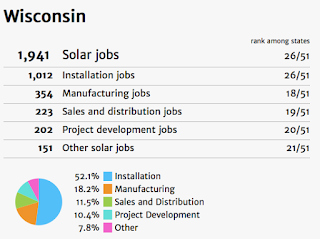
by jboullion | Feb 10, 2016 | Uncategorized
Immediate release
February 10, 2016
More information
Tyler Huebner, Executive Director
608.255.4044 x 1
tyler.huebner@renewwisconsin.org
Wisconsin Solar Industry Employs Over 1,900
Today, The Solar Foundation released the state-by-state results of its annual “Solar Jobs Census.”
Wisconsin’s solar industry employs 1,941 workers according to the Census, across installation, manufacturing, sales and distribution, project development, and related sector employment. That places Wisconsin 26th nationally for the number of solar jobs in the state, and 27th nationally in solar jobs per capita.
The full state-by-state report can be found at http://solarstates.org/, where there is a national map and each state’s data can be accessed.
Milwaukee, Waukesha, and Dane Counties are the three counties with the largest number of solar jobs. Installation jobs account for over half of the total in Wisconsin.
Nationally, the industry grew again at a 20% clip to over 208,000 workers. The report shows there are now three times as many solar workers nationally as coal workers.
“Solar energy is a job-creation engine,” said Tyler Huebner, RENEW Wisconsin’s Executive Director. “While Wisconsin’s solar industry employment is holding steady, nationally, the solar industry grew by 20% for the third straight year. In Wisconsin we are not fully harnessing solar energy’s job creation and economic development opportunities to move Wisconsin forward.”
“Wisconsin’s economy will benefit from improved rules and regulations to unlock solar energy’s true potential – rules like better net metering policies, clarifying third-party ownership (solar leasing), and interconnection policies that govern how simple it is for a home or business to connect solar to the local utility grid,” said Huebner.
The Solar Foundation report shows that Wisconsin gets a “D” grade for both net metering – a policy that determines how a customer is credited for extra energy they produce and put on the local electric grid – and interconnection policies.
Selected images from the Wisconsin page of http://solarstates.org appear below:

by jboullion | Feb 10, 2016 | Uncategorized
 Registration is now open for a Coulee Region solar energy seminar at Western Technical College (WTC) on March 1st. 7 Rivers Alliance, a La Crosse-based economic
Registration is now open for a Coulee Region solar energy seminar at Western Technical College (WTC) on March 1st. 7 Rivers Alliance, a La Crosse-based economic
development organization, will host this half-day forum in partnership
with WTC, Dairyland Power Cooperative, and Xcel Energy.
Targeting Coulee Region community and business leaders, the seminar will bring together energy professionals from the area to discuss best practices in developing both customer-sited solar systems as well as community-scale projects. John Farrell, director of the Economic Democracy Initiative at the Institute for Local Self-Reliance in Minneapolis, will be the featured speaker.
Where: Lunda Center, Western Technical College, La Crosse
When: March 1, 2016, 9:00 AM – 12:30 PM
For program and registration information, visit their website here.




